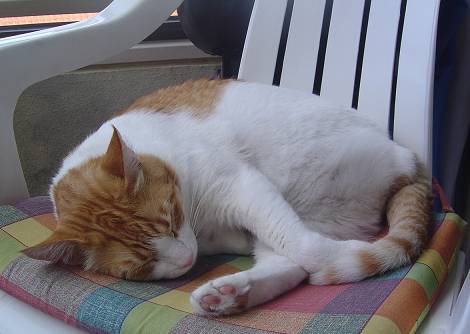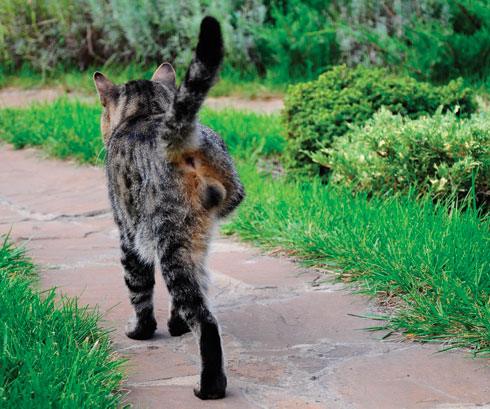Adapting to life on three legs: The story of Buba
Teresa Martins looks at how owners can help their cats adapt to disability and the loss of a limb.
 .
.
Pet cats can sometimes find themselves having to adapt to life on three legs. The loss of a limb can affect normal feline behaviour and activity. Although cats usually find a way to adapt and live a happy life, the adaptation process can be aggravated by the distress of the incident or illness which resulted in amputation.
Buba was a neutered male six-year-old, extrovert and friendly domestic shorthair who lost his left hind limb in a motorbike accident. His story illustrates the process of adaptation pet cats must go through. After surgery, a three-legged cat will find out that for some mysterious reason it is no longer able to perform some tasks it could easily do before. Frustration and anxiety can make the cat feel unsettled and can, in some cases, lead to distress and altered behaviour.
Facing up to life with three legs
Buba’s adaptation to life on three legs was not easy. He became depressed and inactive. He stopped playing, gave up grooming, stopped cleaning himself after using the litter tray and also stopped purring. Perhaps because he felt frustrated, Buba compulsively engaged in a behaviour that still gave him pleasure and caused him no pain: eating.
During the first days after hospitalisation Buba was unsettled, not least because he needed to wear a collar to prevent him from damaging the wound. Initially, Buba also became more introverted and aloof, wary of strangers as he had never been before the accident. However, his extrovert character won the day and over time he gradually lost his fear of strangers.
Physical adaptation may be complicated by hallucinosis (phantom limb). The cat will feel that it can still rely on the missing leg and it may take longer for the cat to find alternative ways of performing tasks that involve the amputated leg. Four years after the accident, Buba still tries to scratch his left ear with his missing leg. Observation of Buba suggested that phantom pain may be a problem in cats, as in humans. Several months after the surgery, when healing was completed, Buba was uncomfortable with his stump being touched. During vaccination, he was extremely reactive when he was injected in his left hindquarters, near the stump. However, this sensation eventually seemed to subside and he could tolerate being touched on the stump.
The role of the owner
Even though a cat’s adaptation to a life on three legs will depend in part on their personality, it is clear this can be a difficult period for the cat. The pain and fear associated with many of the situations leading to limb loss can traumatise and distress the cat as well as adapting to their new limitations. It is important for owners to help their cats to cope with this new situation.
Buba faced a number of practical problems following the amputation. Jumping onto favourite furniture was difficult and he was inclined to give up. To aid him, furniture was rearranged enabling Buba to move from one piece to another, and gain easy access to favoured places. As his confidence and ability increased, so the furniture was moved apart until eventually it was returned to its normal location and Buba was able to go wherever he wanted.
Similarly, to enable him to get up on the bed, a step was provided at the side. As his confidence and muscle tone improved he was able to pull himself up and gained more freedom.
The litter tray was another problem. Despite the removal of its cover and the provision of a step, Buba was reluctant to use it. Buba was helped into the tray each time and initially helped to cover and dig which enabled him to gradually re-learn the habit and adjust to his new situation. Cleaning himself after using the tray was also initially difficult and he needed to be cleaned when he would not clean himself. However, as his balance and skills improved, and when he no longer fell over while trying to turn around to wash, normal grooming and cleaning habits were re-established.
Buba’s compulsion to over-eat was overcome by distracting him with play when he started to search for food. Soon his natural desire to play, along with steady adaptation to life on three legs, overwhelmed his compulsion to eat. A three-legged cat’s body weight should be controlled, as becoming overweight can exacerbate difficulties in them adapting to life. It may be useful to use low-calorie foods, especially as the cat will be less active (at least initially), and especially if they start to over-eat.
In summary, the owner has a critical role during the adaptation of cats to a life on three legs. Some cats adapt quicker than others, but especially when the process falters, a caring owner can help the cat adapt, help motivate them, and help them re-learn or develop new skills. Thoughtful adjustments will help accelerate the process of adaptation to enable the cat to have a full and enjoyable life.
Owning a cat with an amputated limb
International Cat Care helped fund a vet (Lyn Forster) to undertake some important research on improving the welfare of cats which have had limbs amputated for one reason or another.
Her research formed part of the work of the Centre for Animal Welfare, where she worked with Dr Sandra Corr, at Nottingham Vet School in the UK. For part of her work, Lyn surveyed owners of cats which had lost a limb or tail to help us understand better how a cat copes after this sort of loss.
Limb and tail amputations are undertaken to treat different conditions — most commonly in cats this is a result of trauma, very often after being injured in a car accident.

Results of the survey
More than 230 cats with amputations were included in the survey. Some of the results were as expected:
- 80% of the cats were domestic shorthair (DSH) cats – this corresponds to the breed populations in the UK
- Two-thirds of the amputee cats were male – this is probably because males roam further than females, and so are more likely to get into accidents
- Two-thirds of the cats were under four years old – probably because younger cats are less experienced and therefore more likely to come into contact with dangers
- The main causes of amputation were the same in both females and males:
- Trauma, such as broken bones
- Nerve damage, and
- Damage to the skin and muscles.
- The main causes were the same for both leg and tail amputees, although tail amputees had nerve damage as a reason for amputation more commonly
- Few people see the event that caused their cat’s injury, but it was thought in most cases these were caused by road traffic accidents
- Cats were equally likely to lose a left leg as a right leg
- Cats were twice as likely to have a back leg amputated as a front leg. This may be due to several factors:
- The front legs carry more weight than the back legs – it is generally believed that amputation of a back leg will be more successful, so amputation of a front leg may not be offered so frequently
- Cats that have damage to the front leg are more likely to also have damage to the chest, and this may reduce their chances of survival
- It is possible that the back legs are actually injured more commonly as well
Differences between cats and dogs
So a ‘typical’ cat amputee would be a young male DSH, with a leg amputated following a suspected road traffic accident. This is different to what might be expected in dogs, where a typical amputee may well be an older male, probably purebred, who had a leg amputated following a tumour. It quickly becomes apparent that as with other issues, we must look at and consider cats as a unique situation, and not just as small dogs.
How do cats and owners cope with amputations?
Owners were asked questions about their cat’s behaviour, activity, movement, speed, playfulness, mood, body and coat condition, appetite, grooming, and friendliness with humans and other animals.
Interestingly, the only differences noted by owners with a cat amputee were that they tended to be less active and moved slower – in all other aspects the cats were generally no different following amputation. When providing extra information, some owners reported that their cat got tired more easily. These observations probably reflect the increased effort involved in getting about on only three legs, but show that quality of life for most of the cats appears excellent. In fact, over 90% of owners believed that their cats had a normal quality of life after the amputation. This is very encouraging – although there are still 10% of cats do not achieve this, most owners are very satisfied that amputation has not impacted on their cat’s quality of life significantly. When asked whether they would make the same decision if they knew then what they knew now, 95% of owners said they would.
Importance of pain relief
Almost 90% of owners were aware that their cat had received pain relief medication to go home with after the amputation surgery. This is reassuring as the surgery is inevitably painful. However, 36% still thought their cat had been in pain at some point after it had returned home, suggesting improvements could be made. As well as being emotionally unpleasant, pain is known to delay healing, and if we can improve the way pain relief is monitored in these postoperative amputee cats we can potentially improve their speed of recovery as well.
Interestingly, the results of the survey showed that if the owner thought the cat was in pain, the cat took over a month to recover from the surgery, whereas cats that were not in pain took on average only two weeks to recover.
Thank you for visiting our website, we hope you have found our information useful.
All our advice is freely accessible to everyone, wherever you are in the world. However, as a charity, we need your support to enable us to keep delivering high quality and up to date information for everyone. Please consider making a contribution, big or small, to keep our content free, accurate and relevant.
Support International Cat Care from as little £3
Thank you.
Donate Now


